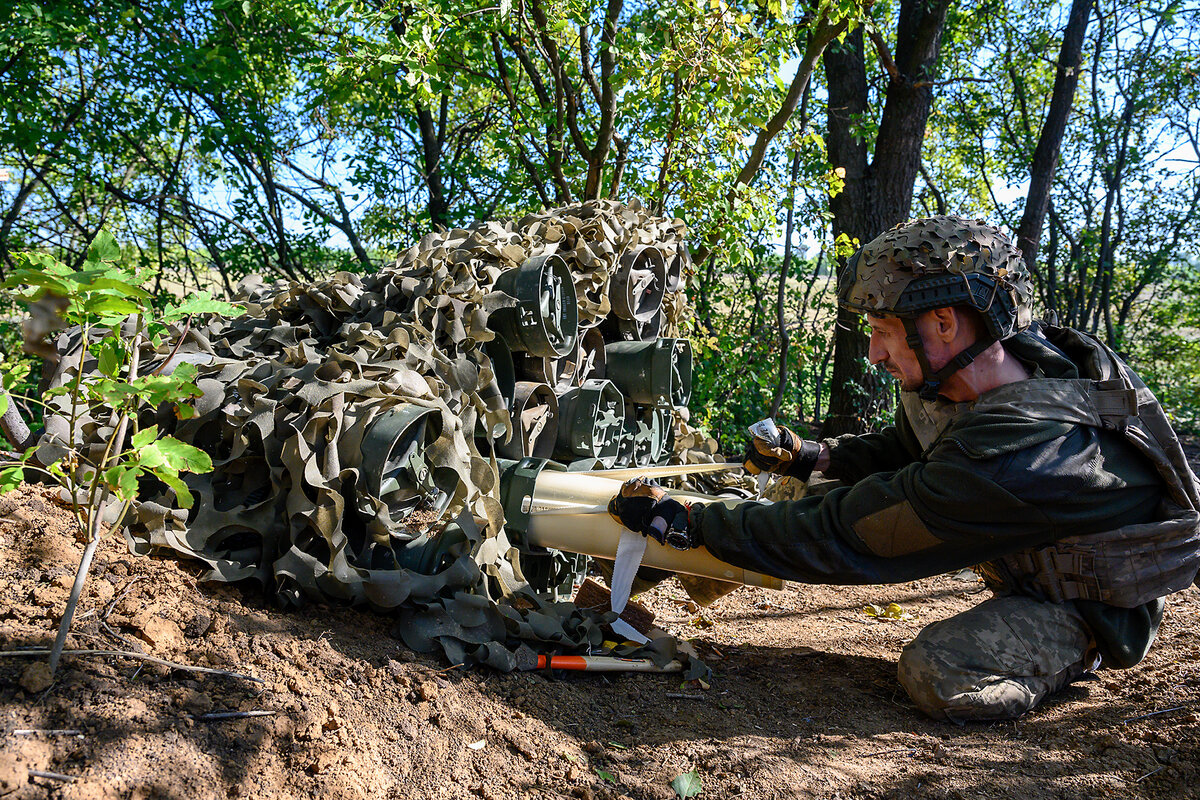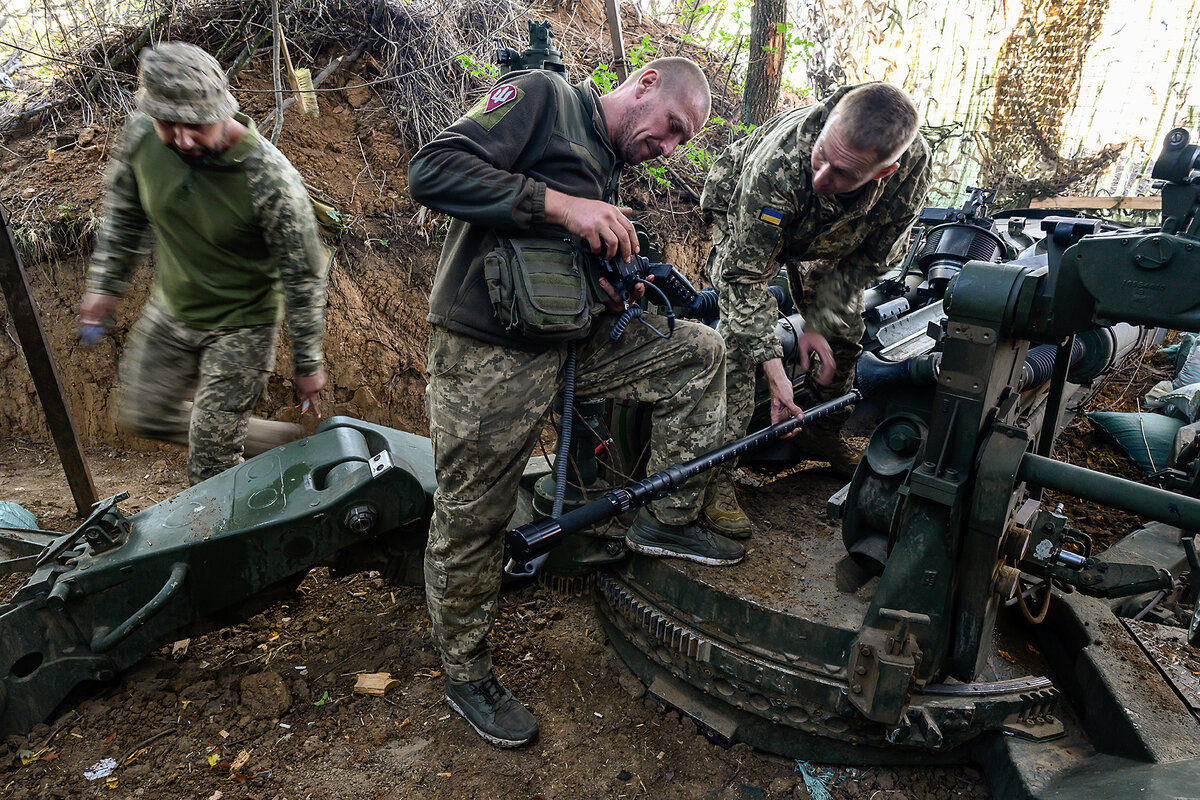How Ukrainians fend off Russia, while awaiting new US military aid
Loading...
| MARINKA DIRECTION, UKRAINE
On paper, the Russian military’s main offensive effort this year against Ukrainian defenders – a May push toward Ukraine’s second-largest city, Kharkiv, in the northeast – was stopped after two weeks with few significant Russian gains. But on the map, Russia’s advances in the past month have been steady along the entire eastern front, even if slow.
On his critical corner of the front line, Ukrainian artillery unit commander Ihor says Ukraine has not suffered major territorial losses since February, but he notes: “We work when the Russians conduct an assault; we work every day.”
Why We Wrote This
A story focused onThroughout their war against Russian invaders, Ukrainian defenders have fought to maintain their morale against a more powerful enemy. After a frustrating wait for supplies, fighters on the front are hoping for a shift in momentum.
Ihor says the severe ammunition shortage his unit had experienced has passed. He ascribes the intensity of the Russians’ offensive to a presumed sense they have a window of opportunity now, before Ukrainian lines are further bolstered by an influx of American and European weaponry and ammunition, which has begun to be felt.
Some 80 miles away, Sgt. Volodymyr Lutsyk, a tank squad commander, says his heavily camouflaged unit, dug into defensive positions, “would like to make advances, but we need more resources to advance.”
Of the new U.S. and European supplies that are in the pipeline, he says: “You can feel the shells arriving, you can feel the effect.”
It is just after 3:30 a.m., and a Ukrainian artillery team’s half-dozen men are asleep in a cramped underground dugout, the dirt walls fortified by logs and the space dimly lit by a single string of green fairy lights.
In the near-darkness, on this southeast corner of the Ukrainian front line, the radio crackles to life.
“They brought us ammunition without telling us,” the awakened radio operator announces.
Why We Wrote This
A story focused onThroughout their war against Russian invaders, Ukrainian defenders have fought to maintain their morale against a more powerful enemy. After a frustrating wait for supplies, fighters on the front are hoping for a shift in momentum.
“At least they are bringing ammo!” says another soldier groggily, in a joking reference to the severe shortage of artillery shells felt just months ago all along Ukraine’s 600-mile front with invading Russian troops.
When the radio crackles again with coordinates of a target, the gunners, from Ukraine’s 148th Separate Artillery Brigade, bolt into action. They dart into the dark trenches outside to get to their gun, an American-supplied M777 howitzer that fires 155 mm shells at the Russian lines.
They roll up the camouflage netting and load and fire one round from the smoke-belching mechanical behemoth, before concealing it again.
Two hours later, lingering Russian drones seeking out their position have departed, and the Ukrainian gunners repeat their moves. They fire 10 rounds in a row, one after another with careful directional adjustments each time, an indication that a Ukrainian drone can see the Russian target and is correcting fire in real time.
“We work when the Russians conduct an assault; we work every day,” says the unit commander who gave the name Ihor, call sign Hellboy, who wears a beard and sideburns beneath a shaved head.
A window for Russia
On this critical corner of the front line, he says, Ukraine has not suffered major territorial losses since the fall of Avdiivka in February, “but the intensity of their [Russian] offensive has a reason.”
That perceived reason is what Russia may see now as a window of opportunity, before Ukrainian lines are further bolstered by an influx of American and European weaponry and ammunition.
Ukraine confirmed a first delivery of long-delayed F-16 jet fighters in recent days, for example, which President Volodymyr Zelenskyy hailed as a “new stage of development” for Ukraine’s air forces.
In June and July, an initiative of the Czech Republic has provided some 100,000 shells – with a total of 500,000 due by the end of the year – a number that Ukrainian officials say has already helped them achieve near-parity now in shell numbers with Russia.
Coming, too, but not yet decisively felt, say Ukrainian officers at several points along the front line, is a colossal $60.84 billion American military aid package, which was delayed for months by Congressional Republicans before passage in late April.
“From March to the middle of spring, we had to save shells,” says Ihor, who gives the rank of “soldier.” “I wouldn’t say it was a crisis, but we had to be precise.” Even now, the explosive charges used to fire the shells can require fine-tuned targeting, because they are supplied by different countries and can be decades old or of varying quality.
“We need something to work with and to fight our enemy,” he says. “We see the effect of that [U.S. and European support] – we get a lot more ammo compared with the spring. … [But] the reality is that we are in defensive positions.”
Russia moves the line
On paper, Russia’s main offensive effort this year – a May push toward Ukraine’s second-largest city, Kharkiv, in the northeast – was stopped after two weeks with few significant Russian gains. In July, President Zelenskyy said some 20,000 Russian soldiers died in those battles, though other estimates have been lower.
The British Ministry of Defense recently calculated Russian casualties to number 1,262 per day in May, and 1,162 per day in June – totaling more than 70,000 for the two months and the highest rate since Russian forces invaded Ukraine in February 2022.
But on the map, Russia’s advances in the past month have been steady along the entire eastern front, even if slow. President Zelenskyy said last week that, after the failure of the Kharkiv assault, Russian forces are now “throwing everything they have” to capture Pokrovsk.
“You can feel the shells arriving, you can feel the effect” of the new U.S. and European supplies, says Sgt. Volodymyr Lutsyk, a tank squad commander some 80 miles to the west, on Ukraine’s southern front. His unit – known as Dmytro Kotsiubailo’s 1st Separate Assault Battalion – is made up entirely of what are thought of as “trophy” tanks captured from Russian forces.
“Of course, we would like to make advances, but we need more resources to advance,” says Sergeant Lutsyk, sitting on a pristine Russian T-72 tank – now dug into the ground and heavily camouflaged – captured when a mine blew off one of its tracks.
“There is no point in us sitting around and defending,” he says. “All of us came here to take back our country; we have the spirit to fight. But we can’t just jump on our enemy and fight head-to-head – we need more resources.”
The tank commander notes that Ukraine is “fighting a very serious enemy” and that there is always room for more ammunition, as both sides evolve and improve.
“For a long time we saw the Russians flailing. They have found their own way out of this with ‘glide bombs,’” says Sergeant Lutsyk, referring to heavy Soviet-era “dumb” bombs that Russia updates with wings and guidance systems and launches to devastating effect from deep inside Russian territory.
“This is an advantage, and we don’t have any answer,” he says. “This has its result, and you can see it on the map.”
Not all are optimistic
Indeed, Ukraine’s commander in chief, Oleksandr Syrskyi, acknowledged Aug. 1 that, amid heavy Russian losses, Russian forces had made “slight advances on the front-line.”
That kind of advantage is why optimism is not universal that the influx of more Western weapons and ammunition – including the arrival of F-16s – can turn the tide of the war for Ukraine.
“I’m not optimistic,” says one Ukrainian front-line military medic active on the eastern front.
“It’s just my personal opinion. If a miracle doesn’t happen, I don’t think we will be able to win this war in our favor,” says the medic, who could not be further identified. “We are not advancing much, and at the same time we spend a lot of resources, a lot of man power, holding onto the positions that we are holding, with a high price.
“Considering the fact that Russia has installed an industrial-level production of munitions and bombs, and they have an endless amount of people – and we don’t have that amount of people – so it’s just the math,” adds the medic.
“Is it really a huge package? They [the U.S.] promised a lot, but what comes? You never know,” says the medic. “If this really will change the balance and we will have an advantage at some point in weapons, then probably, yes – but I don’t know.”
Compared with that of Russian troops, Ukrainians’ far higher morale – as defenders of their territory and locked in what is often portrayed in Ukraine as an existential fight – “is the only thing keeping us afloat for now.”
Fighting and waiting
Still, Ukrainian soldiers along this eastern front also frequently articulate a determination to fight, regardless of the circumstances – but also await enough Western weaponry to enable their aim of eventually forcing Russian troops out of Ukraine.
A team arrives at the artillery position in the Marinka direction, to use a camera device to inspect the M777 gun barrel for wear and tear. It is worn, but still serviceable.
“So what does that mean – can we not shoot another 2,000 shells with this gun?” asks one of the artillerymen, before adding, tongue in cheek: “Or will someone give us a new barrel?”
The battlefield result will almost certainly depend on what arrives, and how it is used in the fight.
“War is going on, and no one can feel safe,” says Oleksii, call sign Cardinal, a military surgeon at a medical stabilization point run by the 66th Brigade in the Donetsk region.
What about the impact of the American aid package?
“I will only be able to say it is effective when I see the results of that, when there will be no more of our wounded soldiers on these [treatment] tables.”
Oleksandr Naselenko supported reporting for this story.











